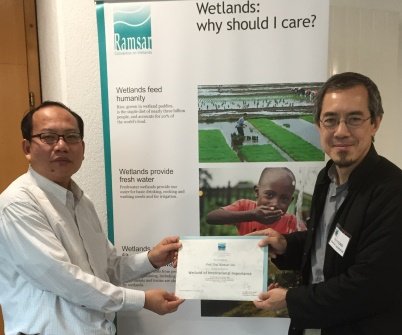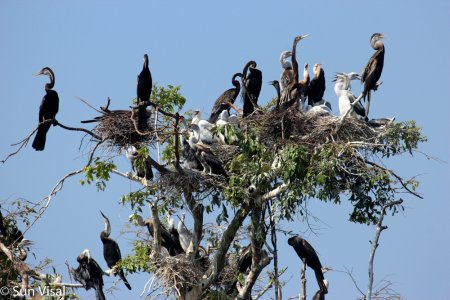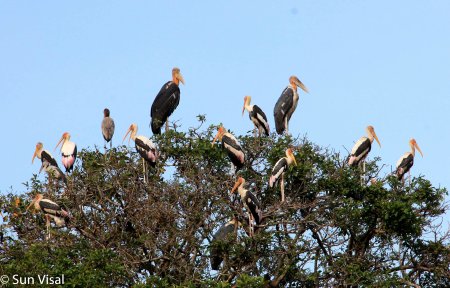Le Cambodge inscrit un nouveau Site Ramsar: les plaines d’inondation de Prek Toal

Le Cambodge a fait de Prek Toal son quatrième Site Ramsar. Couvrant plus de 21 000 hectares, le site comprend quelques-unes des plaines d’inondation les plus intactes de la Réserve de biosphère du Tonlé Sap, au Cambodge. Le site, couvert essentiellement de forêts marécageuses d’eau douce, s’assèche en saison sèche mais en saison des pluies, il est inondé et l’eau atteint une profondeur de huit mètres. Prek Toal se trouve au nord-ouest, en amont du Tonlé Sap et le niveau fluctuant du lac joue un rôle vital pour le maintien de sa richesse biologique.
Les forêts piègent de grandes quantités de sédiments et les matières nutritives déposées stimulent la croissance des plantes et des poissons qui servent de nourriture aux très nombreux oiseaux d’eau et autres animaux vivant dans le site. Prek Toal offre des habitats très variés à la grande diversité d’espèces menacées au plan mondial comme l’émyde fluviale indienne (Batagur baska), le crocodile du Siam (Crocodylus siamensis), la carpe géante du Siam (Catlocarpio siamensis) et le poisson-chat géant du Mékong (Pangasianodon gigas), tous en danger critique. Cette région est unique dans la région biogéographique en raison de la grande concentration et de la diversité des oiseaux d’eau nicheurs (plus de 20 000 comptés régulièrement depuis 2001), avec de nombreuses espèces menacées au plan mondial comme le marabout argala (Leptoptilos dubius) et le grébifoulque d’Asie (Heliopais personatus) tous deux en danger.
Les populations locales habitent des maisons flottantes et vivent de la pêche et de l’aquaculture.

“Cambodia should be proud that Prek Toal has been declared as a wetland of international importance. It recognises the years of hard work between government, local communities and NGOs, and opens the door to many more years of this exciting collaboration that has restored Prek Toal to its place as a natural wonder of Cambodia” said Dr. Ross Sinclair, WCS Cambodia Director.
“We congratulate the Royal Government of the Kingdom of Cambodia for putting forward Prek Toal as a new Ramsar Site”, said Dr. Lew Young, Senior Regional Advisor for Asia-Oceania (Ramsar Secretariat), “and we look forward to supporting the Government of Cambodia to designate more Ramsar Sites in future, and to ensure their sustainable management for the benefit of the local people and the environment.”
30% of Cambodia is covered by wetlands and the majority of them have been identified as globally important, owing to the populations of threatened species that they support. In 1999 Cambodia became a Contracting Party to the Ramsar Convention on Wetlands. However, up until now only three Ramsar Sites had been designated. They are:
• Boeng Chhmar and Associated River System and Floodplain (Ramsar Site no. 997);
• Koh Kapik and Associated Islets (Site no. 998), and;
• Middle Stretches of the Mekong River north of Stoeng Treng (Site no. 999).

“Recognizing Prek Toal as a Ramsar Site not only draws attention to the international importance of this wetland but it will be a bridge for Cambodia to nominate more wetlands as Ramsar Sites in the future”, said H.E. Say Samal, Minister of Environment of the Kingdom of Cambodia.
BirdLife International and the Department of Freshwater Wetlands Conservation, Ministry of Environment have been working together towards designating more wetlands as Ramsar Sites in Cambodia since 2008. Prek Toal is the first new Ramsar Site declared in Cambodia in the last sixteen years. “In addition to its biodiversity value, Prek Toal Important Bird Area delivers ecosystem services such as fish which support the livelihoods of the surrounding floating villages, we are delighted at this result” said Mr. Bou Vorsak, BirdLife Cambodia’s Programme Manager. “Ramsar status for this wetland will attract international interest in this fantastic site.”
Each Contracting Party to the Ramsar Convention designates at least one wetland for inclusion in the List of Wetlands of International Importance, and these sites are selected by the Party based on the site’s international significance in terms of ecology, botany, zoology, limnology or hydrology. Worldwide, there are 2,240 Ramsar Sites, making this the largest network of wetland managed for conservation.
Financial support was provided by the Darwin Initiative, a small grant of Japanese Ministry of the Environment, the Keidanren Nature Conservation Fund, a Ramsar Small Grant, and the Wildlife Conservation Society.